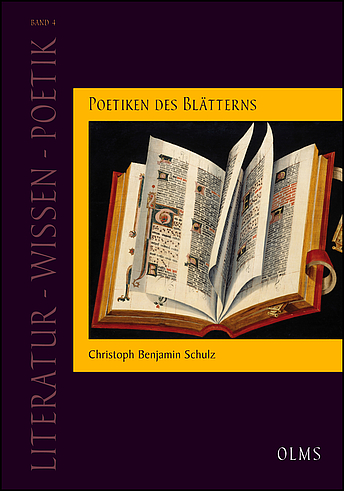Schulz
Poetiken des Blätterns
ISBN 978-3-487-15256-1
englischAnyone who reads, browses. Since the establishment of the codex as the standard form of book in late antiquity, browsing as a cultural technique has been reflected and practiced in religious, academic, social and literary contexts. This study examines aesthetic representations and choreographies of browsing, from the literature of the early modern, baroque and romantic periods to recent artists’ books and current literature. The focus also falls on books outside the literary canon and those intended for browsing rather than reading: oracle books, flick books and blow books, dos-à-dos and other multi-fold bindings, pop-up books and flip books. The study of different traditions and strategies of browsing also offers interesting insights into the function and significance of books as repositories of knowledge, the processes of generating knowledge, the changing conceptions of the book as a data-carrier and a medium for the distribution of literary works, the role of the book in literature and, not least, the early and modern interaction with literary works as a haptic experience. "Proceeding from the premise that the book as object conditioned the presentation and consumption of text, Schulz offers a diachronic exploration of the phenomenon of leafing, discussing both historical uses of the codex predicated on the practice and literary representations of the phenomenon. The result is a rich and intriguing overview of the forms and functions of flicking through books, ranging from antiquity to the late twentieth century. (.) Poetiken des Blätterns offers a treasure trove of examples of the uses of leafing, illuminating both practices and literary explorations of this important quality of the codex." Arnoud Visser, Renaissance Quarterly, Vol. 69, No.4/2016)
Wer Bücher liest, der blättert. Seit der Etablierung des Kodex als Buchform in der Spätantike ist das Blättern als Kulturtechnik in religiösen, wissenschaftlichen, sozialen und literarischen Kontexten sowohl praktiziert als auch reflektiert worden. Diese Studie verfolgt ästhetische Inszenierungen und Choreographien des Blätterns von der Literatur der Frühen Neuzeit, des Barock und der Romantik bis zu den Künstlerbüchern der jüngeren Kunstgeschichte und der aktuellen literarischen Produktion. In den Blick geraten dabei auch Bücher jenseits des literarischen Kanons und solche, die eher geblättert als gelesen werden sollen. Dazu gehören Orakelbücher, Flickbücher und Blowbooks, Mehrfachbände und Vexierbücher, Pop-up-Bücher und Daumenkinos. Die Untersuchung unterschiedlicher Traditionen und Strategien des Blätterns liefert dabei zugleich interessante Erkenntnisse über die Funktion und Bedeutung von Büchern als Wissensspeicher, über Prozesse der Wissensgenerierung, über sich wandelnde Vorstellungen bezüglich des Buches als Datenträger und Distributionsmedium literarischer Werke, die Rolle des Buches in der Literatur und nicht zuletzt über den früheren und gegenwärtigen Umgang mit literarischen Werken als einem haptischen Erlebnis. ----- STIMMEN ZUM BUCH ----- "Der Kunsthistoriker und Literaturwissenschaftler Christoph Benjamin Schulz (…) legt eine fulminante Studie vor, die auch jeden Bibliophilen begeistern wird (…) Eine wichtige Veröffentlichung für die Buchwissenschaft, die Buchkunst, die Kunstgeschichte und die Literaturwissenschaft." (Dieter Schmidmaier, Marginalien 221. Heft, 2/2016) "Proceeding from the premise that the book as object conditioned the presentation and consumption of text, Schulz offers a diachronic exploration of the phenomenon of leafing, discussing both historical uses of the codex predicated on the practice and literary representations of the phenomenon. The result is a rich and intriguing overview of the forms and functions of flicking through books, ranging from antiquity to the late twentieth century. (.) Poetiken des Blätterns offers a treasure trove of examples of the uses of leafing, illuminating both practices and literary explorations of this important quality of the codex." Arnoud Visser, Renaissance Quarterly, Vol. 69, No.4/2016) "Ob Nachschlagen oder Umblättern, Mantik oder Hermeneutik, ob Laurence Sterne oder Konkrete Poesie – Schulz' Buch bietet eine fulminante Neuentdeckung der Literaturgeschichte. Dabei sichtet und verbindet er gleichsam en passant ganz unterschiedliche Forschungsrichtungen (z. B. Leseforschung, Medien- und Methodengeschichte). Wohltuend an dieser ebenso theoretisch reflektierten wie auffallend gut geschriebenen und mit einem instruktiven Bildteil versehenen Monographie ist die Beibehaltung der genuin historischen Perspektive: Der Autor entsagt ohne Ressentiment dem Blick auf ein Zeitalter, in dem aus Texten digitale Hypertexte und aus dem Blättern ein Klicken wird, und entwickelt gerade dadurch sein innovatives Potenzial. Keine Frage: Ein Buch, in dem sich das Blättern lohnt." (Jürgen Gunia, Germanistik 57/2016) „Poetiken des Blätterns ist in vielen Aspekten eine hervorragende Monografie. Die Recherche über die teilweise sehr alten und ausgefallenen Beispiele ist bewundernswert - die wichtigsten Buchobjekte werden dankenswerterweise mit dem Abbildungsanhang auch den Leser_innen zur Verfügung gestellt.“ (Vincent Fröhlich, Zeitschrift für Medienwissenschaft, 2/2107) "Die (…) von Christoph Benjamin Schulz vorgelegte Dissertationsschrift zum Phänomen des Blätterns ist im Rahmen dieses Materialitätsdiskurses zu lesen und kann als Pionierleistung auf einem Gebiet gelten, das zur grundlegenden performativen Erfahrung jeder Beschäftigung mit Büchern gehört." (Peter Goßens, Arcadia 2017; 52 (2))


